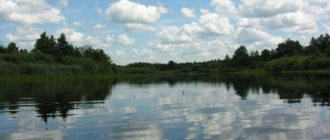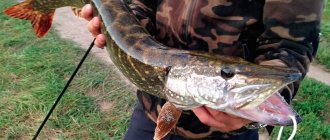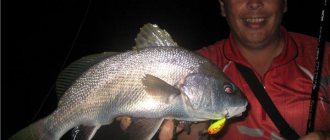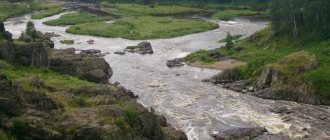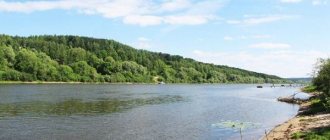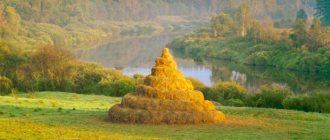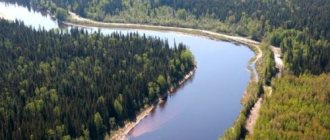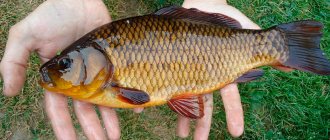Big Irgiz
A unique river. Firstly, it is officially the most winding in Europe. One glance at Irgiz from a bird's eye view, or at a satellite image, is enough to be convinced of this. Secondly, in the 100-kilometer section from the Sulak dam (Krasnopartizansky district) to the connection with the Volga, the direction of the current changes several times a day. For this we should be “grateful” to the work of the hydroelectric power station.
The water level in the Volga fluctuates very much, so the river flows sometimes as it should, sometimes in reverse, for profit. The Irgiz River crosses the entire northern part of the Volga region with a winding ribbon; its mouth is located opposite the city of Volsk. The width in the middle and lower reaches is 100-150m. The water is very muddy in summer, which may have given this interesting river its name. According to some version, the word “irgiz” translated from one of the Turkic languages means “dirty.” On the face of it, this is absolutely true. Freeze-up usually begins in mid-December, and you can start fishing in open water as early as April. On Saturday and Sunday fishing is rarely successful due to low water levels and weak currents in any direction. The exception is the short pre-estuary section from the “three rivers” - the confluence of the Bolshoi Irgiz and the Rsvyaki channel river. The current is always present there precisely because of the action of Revyaka. Three Rivers is a very cool place, but, unfortunately, “wild” tourists camp there all summer. They almost never catch fish, but they completely scare away everything. In the fall, when everyone has left, it’s worth looking for asp there. Sometimes castmasters have enough catfish. The Revyaka is a heavily snagged river. Fishing with non-snagging jigs can be very successful here. In Irgiz itself, at absolutely every turn and bend (and there are so many of them there - every 1.5 - 2 km) there is a decent hole washed out. They are inhabited by pike, pike perch and catfish. Spinners come across the latter quite rarely, and if they do, they often get away with impunity. The size is too large - often for half a centner. In 2006, one of my acquaintances managed to win at the “Popov Corner” pit in Mayang. Three hours of struggle greatly exhausted the participants in the battle, but the huge predator was the first to surrender. Fishing is 99% jig fishing. You can, of course, comb the coastal dump with spinners and wobblers, but then the catch will be dominated by very small pike. More or less decent fish are either along the fairway or in the lower parts of the edges at depths of 4-7 m. The Big Irgiz is simply a paradise for jig fish. Recommended weights of jig heads are from 22 to 40 g, baits are medium, and closer to autumn - large. A long cast is almost always needed - a lot of fish are caught from distant dumps. In general, there are few holds, mainly on the sharp clay edge, but in some places there are also “glues”. There is an impassable windbreak in almost the entire pre-estuary area, in Tupilkin, below the village of Karasi and Trekhrechya. There are a lot of "Buratina" in the area of Krivoluchya and Kormezhka. There are more fish there, but different gear is needed: offset hooks, foam rubber with a pressed double and reliable braided cords of impressive thickness (Aqualon 0.20 mm, Power Pro 0.19-0.27 mm or Tuf Line 20 Lb). But they also chatter very loudly against the “sticks” covered with shells. The most famous and working pits are located in Mayang (Popov corner, Kopytnoe), Krasny Yar (the exit of Erik Podpolny), Tupilkin (the entire area below the farm), Kormezhka (all turns of the river above and below the village). Fishing is interesting above and below the overflow dam in Sulak and near Berezovo. There are many flood lakes and eriks in the floodplain, where you can catch pike with interest.
The main negative in the Greater Irgiz is the fishing camps of semi-legal poachers. The majority have documents, but the methods of extraction and overfishing quotas are simply barbaric. And “Chinese” fishing nets are often used. In some places, “checkered fishing rods” stand from bank to bank every 50 m. Five in a row. Only a large number of spinners are able to survive the hucksters from the river, which is why they are “leaking” the once secret directions.
Big Irgiz River
Bolshoy Irgiz (Irgiz) is a river in the Samara and Saratov regions, a left tributary of the Volga. The length of the river is 675 km, its drainage basin area is 24,000 km². The average annual water flow in the lower reaches is about 23 m³/s. Used for irrigation. Flood in March - April (30 days, 86% of the annual flow). Snow food. Freeze up from November to April (in some places it freezes to the bottom), spring ice drift lasts about 7 days. In summer it sometimes dries out. The flow is regulated by numerous dams. It feeds the Saratov irrigation canal.
Old Believer monastery on the Bolshoi Irgiz River
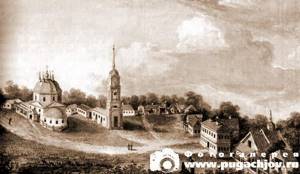
The sources are on the spurs of the General Syrt, flowing, winding strongly, along a wide valley among the plowed steppe; snow food. It flows into the Volgograd Reservoir below the city of Balakovo.
There are 2 large reservoirs on the river: Sulak (water surface area - 20 km², volume - 0.115 km³) and Pugachevskoye (10 km² and 0.06 km³, respectively. The route of the Saratov irrigation canal passes through the water area of the Sulak reservoir. In total, about 800 ponds and reservoirs with a total volume of 0.45 km³.
On the river there is the city of Pugachev, the villages of Belenka, Tolstovka, Bolshaya Tavolozhka, Klevenka, Kanaevka, Preobrazhenka, Uspenka, Kamenka, Davydovka, Tambovka, Berezovo, Kamenka, Pestravka, Bolshaya Glushitsa of the Samara region, the village of Zavolzhsky, the village of Beregovoy (Madhouse), Krivoluchye- Sura, Big Kushum, Vetka, Feeding, Naumovka, Pylkovka, Small Kushum.
Big Irgiz River
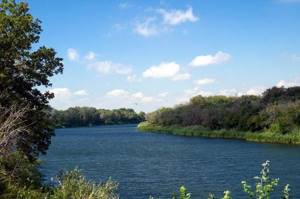
Etymology Irgiz probably comes from Turkic roots meaning bend and river, source. Already in 921, Ahmed ibn Fadlan mentioned the hydronym Irgiz. The definition of Bolshoy has already appeared in Russian usage.
Tributaries Volga basin (km from the mouth) 19 km: Mayanga (Mokraya Mayanga gully) 88 km: Malyi Kushum 128 km: Bolshoi Kushum (Kushum) 239 km: Sakma 273 km: Tolstovka 293 km: Klopikha 360 km: Rubezhka 406 km: Kamelik 425 km: Sister 468 km: Teplovka 472 km: Dry Ovsyanka 476 km: Ovsyanka 493 km: Wet Ovsyanka 528 km: Vyazovka 567 km: Karalyk 585 km: Zhuravlikha 590 km: Sukhoi Irgiz 600 km: Gusikha 614 km: Bolshaya Glushitsa 632 km : Talovka 638 km: Rostashi
A native of the village of Khasanovo, the Bashkir writer Khadiya Davletshina wrote a novel called “Irgiz”, for which she was the first to be awarded the Salavat Yulaev Prize.
Water register data According to the state water register of Russia, it belongs to the Lower Volga Basin District, the water management section of the river is Bolshoi Irgiz from the source to the Sulak hydroelectric complex, the river sub-basin of the river is absent. The river basin is the Volga from the upper Kuibyshev reservoir to its confluence with the Caspian Sea. Big Irgiz River
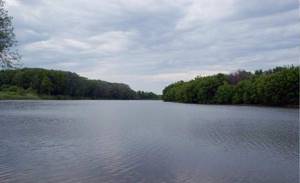
ARTICLE ABOUT THE BIG IRGIZ RIVER The Bolshoy Irgiz River is listed in the Guinness Book of Records as the most winding river in Europe. It originates on the spurs of the General Syrt, on the border of the Orenburg and Samara regions, and winding strongly among the steppes of the left bank, flows through the territory of the Samara, Saratov regions and flows into the Volga, below the city of Balakov. How winding the Big Irgiz can be can be assessed from a map or satellite photographs, as well as by visiting some places of the river, where the distance between two points on the river along the riverbed can be 3-5 times greater than in a straight line. The length of the river in the Saratov region is 458 km; in a straight line this distance is about 150 kilometers.
The tortuosity of the Big Irgiz, its steep banks, and the forests growing along the river played a role in the development of the Old Believers in this region. And now in Irgiz, an area located along the Greater Irgiz, people of the old faith live, preserving the traditions of their ancestors. Therefore, Irgiz is widely known in the Old Believer world. Before the advent of the Old Believers, these were remote places, covered with forests, but often visited by nomadic tribes. And when the Old Believers began to be oppressed in Russia, they began to settle here, in the desert region, hiding in dugouts dug in the forests and steep river banks. The systematic colonization of Irgiz began at the beginning of the 18th century, during the time of government persecution of Old Believers for their religious beliefs. Catherine II, with a manifesto of December 4, 1762, called on the Old Believers who fled from Russia to Poland to return to their homeland and settle on free Russian lands. Due to the tortuosity of the Greater Irgiz, the Old Believers chose places of residence in its hollows and bends, where they could build a dam and dig a pond. Thus, the hermits organized a kind of fortress, surrounded by water on almost all sides for eight months a year. On the Bolshoi Irgiz River there is the city of Pugachev, to which a separate cache is dedicated, but the fate of the cache is currently unclear.
The Bolshoi Irgiz receives its main nutrition from snow (96%), so in the summer there are cases of the river drying out in some areas. And since rivers are the main source of drinking water in the Left Bank (artesian water is too hard), the river flow is regulated by dams. Many dams and reservoirs have been built and organized on the Greater Irgiz. Including 2 large reservoirs - Sulakskoye and Pugachevskoye. The Saratov irrigation canal named after E. E. Alekseevsky runs through the Sulak reservoir, through Irgiz. It was built from 1967 to 1972 for irrigation and watering of the Trans-Volga lands and its length is 127 kilometers. The water of this canal irrigates over 100 thousand hectares of land, 150 thousand. hectares of pastures, supplied with water to 7 districts of the Saratov region and fed by the drying up rivers Bolshaya and Malyi Uzen. The canal begins in the city of Balakovo (N52°1.441′ E47°48.652′), from the Saratov reservoir, from where water flows by gravity into the Sulak reservoir (N51°53.069′ E48°17.713′) and, passing along the Bolshoi Irgiz against its current, continues its journey (N51 °52.620′ E48°22.672′) along the Trans-Volga steppes.
Big Irgiz River
FISHING ON THE BIG IRGIZ RIVER A unique river. Firstly, it is officially the most winding in Europe. One glance at Irgiz from a bird's eye view, or at a satellite image, is enough to be convinced of this. Secondly, in the 100-kilometer section from the Sulak dam (Krasnopartizansky district) to the connection with the Volga, the direction of the current changes several times a day. For this we should be “grateful” to the work of the hydroelectric power station.
The water level in the Volga fluctuates very much, so the river flows sometimes as it should, sometimes in reverse, for profit. The Irgiz River crosses the entire northern part of the Volga region with a winding ribbon; its mouth is located opposite the city of Volsk. The width in the middle and lower reaches is 100-150m. The water is very muddy in summer, which may have given this interesting river its name. According to some version, the word “irgiz” translated from one of the Turkic languages means “dirty.” On the face of it, this is absolutely true. Freeze-up usually begins in mid-December, and you can start fishing in open water as early as April. On Saturday and Sunday fishing is rarely successful due to low water levels and weak currents in any direction. The exception is the short pre-estuary section from the “three rivers” - the confluence of the Bolshoi Irgiz and the Rsvyaki channel river. The current is always present there precisely because of the action of Revyaka. Three Rivers is a very cool place, but, unfortunately, “wild” tourists camp there all summer. They almost never catch fish, but they completely scare away everything. In the fall, when everyone has left, it’s worth looking for asp there. Sometimes castmasters have enough catfish. The Revyaka is a heavily snagged river. Fishing with non-snagging jigs can be very successful here. In Irgiz itself, at absolutely every turn and bend (and there are so many of them there - every 1.5 - 2 km) there is a decent hole washed out. They are inhabited by pike, pike perch and catfish. Spinners come across the latter quite rarely, and if they do, they often get away with impunity. The size is too large - often for half a centner. In 2006, one of my acquaintances managed to win at the “Popov Corner” pit in Mayang. Three hours of struggle greatly exhausted the participants in the battle, but the huge predator was the first to surrender. Fishing is 99% jig fishing. You can, of course, comb the coastal dump with spinners and wobblers, but then the catch will be dominated by very small pike. More or less decent fish are either along the fairway or in the lower parts of the edges at depths of 4-7 m. The Big Irgiz is simply a paradise for jig fish. Recommended weights of jig heads are from 22 to 40 g, baits are medium, and closer to autumn - large. A long cast is almost always needed - a lot of fish are caught from distant dumps. In general, there are few holds, mainly on the sharp clay edge, but in some places there are also “glues”. There is an impassable windbreak in almost the entire pre-estuary area, in Tupilkin, below the village of Karasi and Trekhrechya. There are a lot of "Buratina" in the area of Krivoluchya and Kormezhka. There are more fish there, but different gear is needed: offset hooks, foam rubber with a pressed double and reliable braided cords of impressive thickness (Aqualon 0.20 mm, Power Pro 0.19-0.27 mm or Tuf Line 20 Lb). But they also chatter very loudly against the “sticks” covered with shells. The most famous and working pits are located in Mayang (Popov corner, Kopytnoe), Krasny Yar (the exit of Erik Podpolny), Tupilkin (the entire area below the farm), Kormezhka (all turns of the river above and below the village). Fishing is interesting above and below the overflow dam in Sulak and near Berezovo. There are many flood lakes and eriks in the floodplain, where you can catch pike with interest. The main negative in the Greater Irgiz is the fishing camps of semi-legal poachers. The majority have documents, but the methods of extraction and overfishing quotas are simply barbaric. And “Chinese” fishing nets are often used. In some places, “checkered fishing rods” stand from bank to bank every 50 m. Five in a row. Only a large number of spinners are able to survive the hucksters from the river, which is why they are “leaking” the once secret directions.
Big Irgiz River
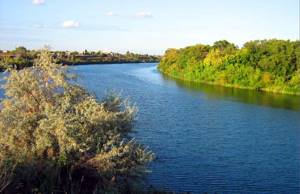
Fishing in the Saratov region took place in the summer in the vicinity of the city of Balakovo on the Bolshoi Irgiz River. The reservoir is very diverse, with different depths, and there is a current. Before we go out on the water, we’ll prepare the gear we’ll use to fish on the Irgiz. The reservoir is familiar to anglers, but the fishing conditions are different every year. This year the level on the river is quite high, it is unknown how the fish will behave. Therefore, we took with us completely different gear for different conditions. Let's start fishing in the Saratov region with deep jig baits. They will be different variations: silicone baits, vibrotails. Let's try to use sinking and floating variations of wobblers.
Fishing lures for catching predators Pike can stand not only at the very bottom, but during the day it will also rise and actively walk and hunt. Naturally, we will try heavy oscillating spoons and micro-oscillators. Fishing in the Saratov region for pike on streams on the first day. We chose the first point in a tributary of the Volga to start fishing, which is why it was interesting after the ban, at the end of June. First of all, these are leaks. Water flows out of the floors, as a rule, a stream of fry is formed, in which perch and other predators frolic. And along the dumps from the leak there are large pike and pike perch, for which we basically came to these wonderful places for spinning fishing. Naturally, we start fishing with a jig, since the depth reaches 10-12 meters at the bottom of the dump, along the slope 4-5. The very first stop at the outlet closest to the camp brought a whole scattering of caught pikes. How the exciting fishing went, more details in the video.

Summer fishing on the Bolshoi Irgiz River, second, third day. In the first part of the video, we arrived at the Bolshoi Irgiz River and set up a tent camp. We lowered the PVC boat into the water, collected the gear and at the first chosen point we caught several toothy pike predators. The journey along the Irgiz continues along the river upstream towards the Revyaka channel. This time the fishermen were out of luck. At lunchtime, the water level of the Volga rose and the leaks, which were actively dumping water in the morning, flowed back. In such a situation, it is usually not worth waiting for effective bites. We were once again convinced of this by conscientiously working on each of the areas we had planned. Neither changing baits, nor various combinations of wiring, nothing could motivate the predator to attack. In addition, noon came, the air around us became hot and our heroes had no choice but to climb into the water themselves and wait for the evening to approach. Let's hope that by then the heat will subside, and our fishing in the Saratov region on the Irgiz will take place at a more comfortable temperature. We begin our evening departure with a visit to a promising snag grower. The place is quiet, the current is small, the depth is from 5 to 8 meters, the bottom is bumpy and uneven. The echo sounder shows the presence of fish. Let's try to hunt for zander or pike.
Fishing for pike perch in the Saratov region Having caught the long-awaited pike perch, we continue fishing this place, throwing bait under the coastal dump, tapping and probing promising areas of the bottom relief, looking under every snag that interests us in the hope of a response from a toothy beauty or another fanged predator. And the pike really caught.
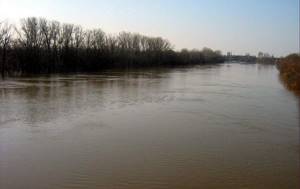
LEGENDS OF THE GREAT IRGIZ RIVER In these remote regions, rich in game and fish, in the distant past - in the 7th - 5th centuries BC, tribes of Sauromatians (carriers of Scythian culture) and Sarmatians roamed and lived, who exterminated part of the Scythian inhabitants. This is where the legend of the steppe river begins. The Sarmatian khan had a beautiful daughter. She fell in love with a Scythian youth from a poor family. The Sarmatian population looked down on the vanquished, and therefore the young people were not destined to unite. Out of grief and despair, the girl threw herself into the river and drowned. Her name was Irgiz. This event amazed not only the girl’s parents, but also all her fellow tribesmen. The place where the girl died was named Irgiz. Soon the whole river began to be called that. During the Bronze Age, the first settlements appeared here, their remains were discovered along the shores of Lake Kalach and the Bolshoy Irgiz River. At the end of the 4th century AD. the cruel Huns (Mongoloid race) came here, destroying everything in their path. At the end of the 9th century, hordes of Pechenegs roamed and lived in these places. During these periods, most of the conquerors came to the Russian state from the East, bringing with them troubles and destruction to the peoples living here. Among the attackers were different tribes. Another legend about a steppe river is associated with one of these invasions. The word “iris” is translated from Greek as “rainbow”. The iris flower got its name for its extraordinary beauty and iridescent colors. A miracle of nature, the rainbow has always delighted people with its mysterious beauty. And on this day, a heavenly phenomenon disturbed the soul of the warrior-poet. A rainbow shining with freshly washed colors spread across the entire dome of the post-storm purple sky. One end of it sank into the waters of the river, agitated by bad weather, and the other, apparently, into the same steppe river. Taking in the mirror-like splashes of the river drop by drop, the rainbow became brighter and brighter.
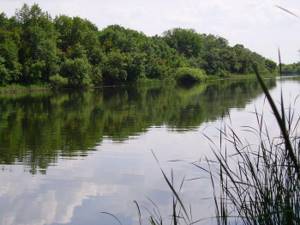
And then the poet exclaimed: “Iris flower! Look, the iris has bloomed in the sky!” - "Where?" — the warrior standing next to him did not understand. “Look, look! One flower petal clings to the river, and the other drinks water from a seething beauty like this one! I swear I will find that river too!” The nomads went west. Left behind are the vast expanses of Kazakhstan, where the poet called one of the tributaries of the Turgai River Iris. But the warriors reinterpreted it in their own way - Irgiz. So this word sounded clearer and more harmonious to them. Irgiz is like the blow of a whip, irgiz is the screech of a sword in battle. The river has retained this name to this day. When the tribes entered the Trans-Volga steppes, they saw the second river and were amazed at its beauty. Its waters rushed from east to west, now rushing forward, now slowing down. In the rays of the setting sun, the water flowed, playing with all the colors of the rainbow. Seeing this, the poet exclaimed: “I found a river in which a rainbow drank moisture!” And he also called her Irgiz. Only, unlike the Kazakh Irgiz, this Irgiz was named Big, because in the summer months it did not dry out like that one, but majestically carried its waters to the mighty Volga, washing the fertile banks with them. During the same period, the Bashkirs settled here for a long time. To this day, they live in the upper reaches of the B. Irgiz and Kamelik rivers, forming the basis of the population of this area. This people created many beautiful legends and tales associated with the names of tracts and local rivers. Here is one of them. The Bashkirs were then ruled by biys. One biy had a daughter - the beautiful Gulistan. Kalmyks roamed next to the Bashkirs. Their khan, the ruler of a then weak people, fell in love with Gulistan and wanted to marry her at all costs. He invited the Bashkir biy to marry his daughter to him, but the biy told him that he could not do this without the consent of her and his people. Gulistan refused to marry a man from another nation and another faith and called on her people to fight against the Kalmyks. Hearing this, the Kalmyk Khan sent his detachment of soldiers to the Bashkirs. The detachment attacked and recaptured the cattle from the Bashkirs. Thus began the enmity between these peoples. One day the Bashkirs learned that the Kalmyks were going to take Gulistan from them. They went out to meet the enemy, armed with spears and swords. The battle has begun. Gulistan and his father watched her from a high place. From here the biy led his soldiers. Suddenly the girl saw that the Bashkirs were being pushed back and the Kalmyks were beginning to defeat them. Then she mounted her horse and stood in front of her squad. Inspired by this act of Gulistan, the Bashkirs perked up and rushed into battle again. Their onslaught was so strong that the Kalmyks could not stand it and fled. Many of them remained on the battlefield.
overflow dam on the Bolshoy Irgiz River
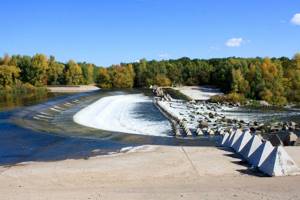
The Bashkirs rejoiced. They named the valley where this victory was won after the girl - the winner - Gulistan, and the river flowing through this valley, on the banks of which the Bashkirs celebrated their victory, honored Gulistan, they called Ir-Kyz, which translated into Russian means “well done young woman". The wise Irgiz told many events in his lifetime. According to the recollections of the guards, there was once clean water in the Bolshoi Irgiz, the river was rich in fish and crayfish. Near the water, cows wandered through the meadows, horses were driven to the river at night to graze, people walked to the river with buckets for water, they brought clothes to the river to rinse, and in the evenings, village girls gathered to sing songs by the river. Swimming in the summer, bonfires on the banks in the fall, sailing in a boat in the spring floods...
Look around, slow down! Belatedly, the dandelion balls turn silver. Maple, elm, and oak trees illuminate the clearing with green light. Everything is immersed in silence and confused by the glare of the sun on a fine day.
Sometimes I often dream Like the cry of an autumn bird. A harsh land, a distant land Where you and I were born. Where, ring by ring, the river draws across the steppe. For some it is small, but for us the Big Irgiz. V. Fadin.
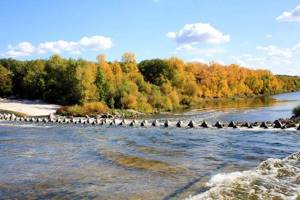
SOURCE OF PHOTO AND MATERIAL:
Surface water resources of the USSR: Hydrological knowledge. T. 12. Lower Volga region and Western Kazakhstan. Vol. 1. Lower Volga region / Ed. O. M. Zubchenko. - L.: Gidrometeoizdat, 1966. - 287 p. https://www.geocaching.su/ Irgiz River. State water register. https://mesto-kleva.ru/ Blue Book of the Samara Region: Rare and protected hydrobiocenoses / Edited by Corresponding Member. RAS G. S. Rosenberg and Doctor of Biological Sciences S. V. Saksonov. - Samara: SamSC RAS, 2007. - P. 121. - 200 p. — ISBN 5-93424-189-3 Samara toponymy https://fishingkalina.ru/ Work of libraries in the Saratov region with local history literature. / Kryaneva E.E., Saratov – 1997; Historical essay about the Russian development of the Volga region and the Trans-Volga city of Pugachev. / Dushkov V.Yu, Saratov – 2007; Zhukova V. City of Pugachev. 1989.
Irgiz is a river in the Samara and Saratov regions. Description, recreation and fishing
Everyone wants to go on vacation in the summer to a beautiful place where you can forget about your problems, worries and just enjoy nature. Some people like to escape from everyday worries by fishing. But it’s not for nothing that quite a lot of vacationers choose the Irgiz River as a good place to relax. It is located near Samara and Saratov. It has beautiful views and is rich in different types of fish. A holiday in this area will be remembered for its picturesque landscapes. Therefore, everyone will want to come back.
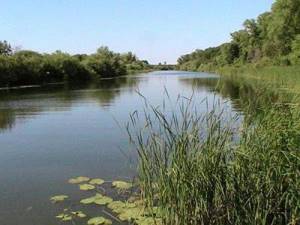
Tourism and recreation on the Bolshoi Irgiz River
The Bolshoi Irgiz River is located in the arid zone of temperate climate, in the belt of forest-steppes and steppes. This is an ideal option for all existing types of recreation, and especially extreme leisure. There is both a forest (for hunter-gatherers and camping enthusiasts) and a lot of open spaces for extreme fun such as jeeping and bugging, horse racing and even flying on all sorts of devices. You will also enjoy skydiving. In Balakovo. In winter, it is convenient to ride snowmobiles and do underwater fishing. The shores will delight you with fish pools, and in some places – steep holes and even caves (a paradise for rock climbers or speleotourists). And getting to different parts of the main river basin will not be difficult - the river is intertwined with such roads as A-300, Bolshaya Chernigovka - Kostino, Engels - Samara, Bolshaya Glushitsa - Makaryevka. There are railway stations in Pugachevo and Balakovo. There are also primers. And this is a special joy for cyclists.
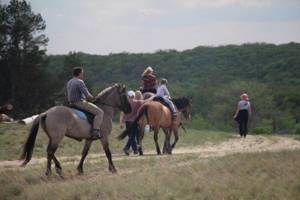
The Bolshoy Irgiz River will greatly delight equestrian lovers. Balakovo and Pugachev have clubs for lovers of horseback riding. The tours include both short dressage rides and fairly long horse rides. Horseback riding is beneficial for children aged 5 years and older. And instructors are provided for such kids.
Beach holidays on the Bolshoy Irgiz River are good almost everywhere. But there are places “out of competition”. We are talking about pieces of sushi in a garla, the perimeter of which is wide sand spits. And also about Bolshaya Glushitsa, the “bathing” ponds of Pestravka, Pugachev and Balakovo. But the cleanest and most gentle shallows are located around the mouth of Revyaka. There are river islands. At the described points no one will spoil the privacy. After all, there are no camp sites at the designated hydrological site.
Event recreation on the Bolshoi Irgiz River is combined with agricultural and pilgrimage. Every year people are attracted by the historical reconstruction “Pugachev's Rebellion” (Pugachev) and the “Strawberry Festival” (Balakovo). The events attract many guests.
Rafting on the Bolshoi Irgiz River is a fairly common activity. But the initial section of a hydrological object can serve as a road only twice every three years. In a “wet” year, a water trip usually starts from Pugachev. Pros go below Bolshaya Tavolozhka or from Staraya Porubezhka. In this picturesque village you can get on the water any year. Water never leaves these recreation areas. And the width is already 80 meters in summer and 100 in high water. However, such “water workers” will subsequently have to enclose the dam of the Pugachev “Sea”. Let’s note about the flood: during it the water looks even cloudier than usual. It is brown.
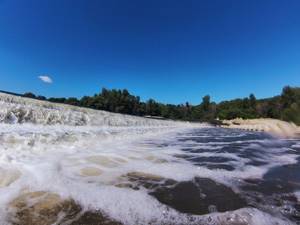
Travelers will immediately feel the peculiarity - slow movement (especially in extensions) and a sharp increase in speed directly on turns. And there are a very large number of them. So the movement is kind of spasmodic. But above Staraya Porubezhka the channel is categorical: shallows, congestion at narrowings, and so on.
Hydrography of the Irgiz River
Irgiz is a river that has a length of 675 km. The area of its pool is 24 thousand square meters. km. Typically, the river is used to irrigate local fields. High water is typical for March-April. The water flow is fed by snow waters. In spring, ice drift lasts no more than a week. Ice on the river lasts from November until the second month of spring. In some areas the depth is so shallow that the ice covers the entire water flow - to the bottom. It often dries out in the summer. The Irgiz overflow dam controls the flow. In addition to it, there are several more dams here. Is one of the ways to feed the local channel.
The source of the river is in the General Syrt area. The current is of medium speed, the channel has the shape of a loop in some places. The mouth is the Volgograd Reservoir (Balakovo). Irgiz is a river on which two more artificial reservoirs are based: Sulakskoye and Pugachevskoye. The first has an area of 20 squares, the second - 10 km 2. There are more than 800 small ponds and reservoirs in the Irgiz basin.
History of the name
The history of the origin of the hydronym Big Irgiz has not been reliably established.
One version claims that the name is derived from the Turkic “yrg”, which means “hook”, “bend”.
A beautiful Bashkir legend was recorded in 1924 by the first director of the local history museum of the city, Pugacheva K.I. Zhuravlev.
According to legend, the word “ir-kyz” translated from Bashkir means “well done girl” or “hero girl”: “ir” means well done, hero, “kyz” means girl.
The Kalmyk Khan wanted to marry the beautiful Gulistan, the daughter of a Bashkir rich man. The girl refused to marry someone she didn’t love. Then the Kalmyks gathered a detachment to take Gulistan from their father by force. The armies of the Bashkirs and Kalmyks met in the river valley. They fought bravely. But the Bashkirs wavered under the pressure of the enemy and ran. Then the brave Gulistan jumped on her horse and rushed to her compatriots to support their morale. The girl began to fight the enemy on an equal basis with men, showing them an example of courage and bravery. As a result, the Bashkirs won. They began to say about Gulistan that she had the heart of a lion, and they called her Ir-kyz. The river on which the victory was won received the same name.
Fishing on the river
The fishing season should start in April. Fishing in the Samara region attracts many due to good conditions. By the way, it is best to do this on weekdays. This is due to the fact that there are too many vacationers on weekends. However, if it is not possible to come during the working week, you should stay at the junction of Irgiz and Revyaki - on Trekhrechye. Thanks to the influence of the Revjaka, the current in this place is optimal for fishing. The best time to come to Trekhrechye is in the fall. The thing is that in the summer, vacationers here scare away prey.
There is an opportunity to catch asp and catfish. Irgiz is a river where it is best to fish with jig baits. Fishermen wishing to supplement their catch with pike or zander are advised to stop at the bend. In these places there are pits in which the listed fish live. It’s quite difficult to catch catfish, but it’s almost impossible with a spinning rod. This is due to the too large weight of representatives of this species - half a centner.

Bolshoi Irgiz is a place where you can have a good rest and not fear for your safety. There is an overflow dam on the river, which is also called “Waterfall” or “Steps”. Due to the convenience of recreation there, quite a lot of tourists gather here in the summer. In the Saratov region, this is the only place where you can enjoy swimming, beautiful views, and splashes of water slides. You can also see a wonderful sight - how cars overcome the path, driving along the dam. You can watch many videos of such people who like to take shortcuts.
How to get to the dam, being near the river itself? You can approach both from the right banks and from the left. In the first case, you need to follow the path near the village of Perekopnaya Luka. After driving a certain distance, the driver and passengers will be able to see the green coast, where, by the way, there is no garbage at all. You can also get there from the village of Sulak. In this case, travelers will stumble upon concrete slabs. Here you can drive directly to the shore itself. Please note that there is a “No Swimming” sign in this area. But when has that ever stopped anyone? You can relax with children near the breakwaters: the depth here is very shallow, in some places it is no higher than the ankle. But if you really want to swim, you need to climb a little higher than the dam.
The best fishing in the Samara region is in these places! We can say this with 100% confidence. An indicator of this is the frequent sighting of herons. Notice! The waterfalls on the dam dry up quite often, so you need to come before it gets hot – in early summer. Also, those people who want to visit the dam by car should remember that some took a risk and went on an exciting journey along the waterfalls.
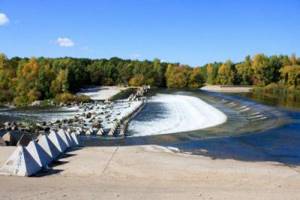
Geographical information
The length of the river is 675 km, its drainage basin area is 24,000 km². The average annual water flow in the lower reaches is about 23 m³/s. Used for irrigation. Flood in March - April (30 days, 86% of the annual flow). Snow food. Freeze up from November to April (in some places it freezes to the bottom), spring ice drift lasts about 7 days. In summer it sometimes dries out. The flow is regulated by numerous dams. It feeds the Saratov irrigation canal.
The river originates on the border of the Orenburg and Samara regions, its sources are located on the spurs of the General Syrt, and flows, winding strongly, along a wide valley among the plowed steppe. It flows into the Volgograd Reservoir below the city of Balakovo.
There are 2 large reservoirs on the river: Sulakskoye and Pugachevskoye. In total, about 800 ponds and reservoirs with a total volume of 0.45 km³ have been built in the Bolshoy Irgiz River basin.
Water turbidity reaches 0.51 kg/m³; The suspended sediment flow is 0.35 million tons/year. Water mineralization increases downstream of the river: from 835-925 mg/l in the upper reaches to 1230–1430 mg/l in the lower reaches. According to the chemical composition, the low-flow waters of the river belong to the chloride class and the sodium group. The water is moderately hard and the quality corresponds to slightly polluted water.
On the river is the city of Pugachev, the villages of Belenka, Tolstovka, Bolshaya Tavolozhka, Staraya Porubezhka, Imeleevka, Klevenka, Kanaevka, Yablonovyi Gai, Gorelyi Gai, Preobrazhenka, Uspenka, Kamenka, Davydovka, Tambovka, Berezovo, Kamenka, Pestravka, Bridges, Dmitrievka, Bolshaya Glushitsa, Samara region, Zavolzhsky village, village. Maloe Perekopnoe village Perekopnaya Luka, village. Sulak, the village of Sukhoi Spur, the village of Beregovoy (Durdom), Krivoluchye-Sura, Bolshoi Kushum, Vetka, Bykov Spur, Kormezhka, Naumovka, Pylkovka, Maly Kushum.
The largest tributaries of the river: Rostashi, Talovka, Bolshaya Glushitsa, Gusikha, Sukhoi Irgikh, Zhuravlikha, Karalyk, Vyazovka, Ovsyanka.
According to the State Water Register of Russia, it belongs to the Lower Volga Basin District, the water management section of the river is Bolshoi Irgiz from the source to the Sulak hydroelectric complex, the river sub-basin of the river is absent. The river basin is the Volga from the upper Kuibyshev reservoir to its confluence with the Caspian Sea.
How to get there?
As already mentioned, you can come here by car. First you need to get to Balakovo. This can be done by following the Saratov-Samara highway. After reaching the settlement, you need to get to Pugachev. After the driver reaches the Dry Spur, he will see a special sign. He needs to turn right. Then drive 2 km along an asphalt road. Along the way you will meet 2 bridges in the form of a dam. After overcoming the second one, you need to drive into the field, there will be a fork of three roads. You need the one that is knurled the most (far right). It will lead to the river bank. Irgiz (Balakovo district). Drive about 1 km. The second way to get here is public transport. Buses run from Saratov to the following settlements with some frequency: Pugachev, Samara and Ivanteevka.
Dam
Bolshoi Irgiz is a place where you can have a good rest and not fear for your safety. There is an overflow dam on the river, which is also called “Waterfall” or “Steps”. Due to the convenience of recreation there, quite a lot of tourists gather here in the summer. In the Saratov region, this is the only place where you can enjoy swimming, beautiful views, and splashes of water slides. You can also see a wonderful sight - how cars overcome the path, driving along the dam. You can watch many videos of such people who like to take shortcuts.
How to get to the dam, being near the river itself? You can approach both from the right banks and from the left. In the first case, you need to follow the path near the village of Perekopnaya Luka. After driving a certain distance, the driver and passengers will be able to see the green coast, where, by the way, there is no garbage at all. You can also get there from the village of Sulak. In this case, travelers will stumble upon concrete slabs. Here you can drive directly to the shore itself. Please note that there is a “No Swimming” sign in this area. But when has that ever stopped anyone? You can relax with children near the breakwaters: the depth here is very shallow, in some places it is no higher than the ankle. But if you really want to swim, you need to climb a little higher than the dam.
The best fishing in the Samara region is in these places! We can say this with 100% confidence. An indicator of this is the frequent sighting of herons. Notice! The waterfalls on the dam dry up quite often, so you need to come before it gets hot – in early summer. Also, those people who want to visit the dam by car should remember that some took a risk and went on an exciting journey along the waterfalls.
Rest on the river
The coastline is equipped with beaches. Particularly popular is the “wild” part that surrounds the Greater Irgiz. It is there, among the birches and aspens, that tourists often set up a tent camp and live for several weeks, or even months. This stunning location is perfect for fishermen, beach lovers and children. The water in the stream is quite warm. It warms up quickly, especially near the “waterfalls”. There are special tents near the beaches where you can rent various equipment. This will allow you to spend your rest time with even greater benefit.
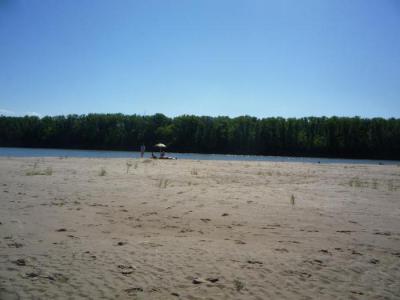
Although the aquatic vegetation is not at all pleased with the variety of species, many rare representatives of the flora are found here. For example, a small population of broadleaf cattail. Egg capsules, reeds and lilies - what could be more beautiful? They enchant the eye and do not allow you to tear yourself away from the enjoyment of nature. If we consider the territory beyond the coastal zone, then it is worth mentioning the forest space. Willows and aspens are the most common. They are easy to see every few meters as you approach the river. Dandelions, wormwood, mouse peas, tansy, plantain and many other plants delight with their abundance in the forest zone. The right bank of the Irgiz River (Saratov region) is almost overgrown. The forest stretches for 150 meters. Major trees include oak, poplar and aspen. The predominant herbs are those that easily tolerate the lack of sunlight or love shade.
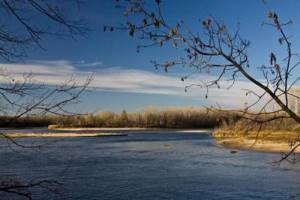
Irgiz is a river in the basin of which the fauna is quite rich. Hares and pheasants are common. If you go deeper into the forest, you can see foxes and wild boars. As a rule, they approach water in places where there are no people. And without “witnesses”, wild boars love to swim in the river and mess around in the mud on the shore. On the shore there are toads, midges, ants, vipers and snakes, otters and, of course, mosquitoes. Birds include storks and seagulls.
Basin of the Bolshoi Irgiz River
Throughout its entire length (with some exceptions), the riverbed is covered with narrow or fairly spacious floodplain arboretums. Before Preobrazhenka, the Bolshoi Irgiz River only gains width and depth, flowing in a well-cut valley. The starboard side prevails in height by at least 6, later by 2-3 meters. And further, with the confluence of Rubezhka (at Staraya Porubezhka), even in summer, the distance between the banks is 80 m. Then the flow of the Bolshoi Irgiz River expands, as it leaves the inter-hill part of the General Syrt. The confluence point of Rubezhka is approximately the center of the entire waterway. There are no hills here. The banks cease to be steep at the intersection with the Saratov Canal. Here, the flow of the Bolshoy Irgiz River passes through the Sulak reservoir and an overflow dam (more about it in the “Attractions” section). Before this (before Pugacheva), Irgiz will visit the narrower Pugachevo reservoir. Here the riverbed begins to sag more and more to the south. At the beginning of its lower reaches, the Bolshoi Irgiz River basin absorbs the deepest and longest tributaries. In addition, his path becomes more winding and confusing (due to oxbow lakes on the sides). Both edges cease to differ in terms of elevation. The floodplain is expanding. The lowermost basin of the Bolshoi Irgiz River is famous for the fact that a channel that is wider than it branches off from it.
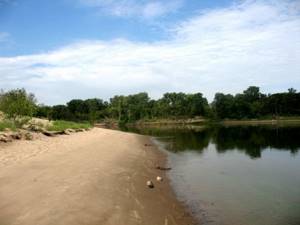
This is Revyaka (Big Revyaka). It begins in front of the Samara Forests tract. This is an island, since the nickel is cut off from the north by Sukhaya Volozhka. The Bolshaya Revyaka flows into the Volga opposite the Volga island of Pustynny, scattering into 3 of its own banks. In the indicated places of the Volga-Great Kyrgyz floodplain, an impassable windfall is often recorded. The branch of the main Irgyz bank is described in the chapter above.
Balakovo. Fishing
The Saratov region is famous for its many places for good fishing. There are especially many of them in Balakovo. The well-developed industry here creates good conditions for fishermen, thanks to warm runoff, as well as natural reservoirs. The main water artery is the Volga. Also attracting fishing enthusiasts are Bolshoy and Maly Irgiz, Revyaka, and the Saratov Sea.
Fishing in Balakovo has the main feature - year-round. It's just as interesting here in winter as it is in summer. Free fishing is common on the Discharge Canal or Technical Lake, which is formed by warm industrial wastewater. The canal is 3 kilometers long and 100 meters wide. From warm, clean water, fishermen often catch carp, crucian carp, and bleak. In Balakovo it is possible to organize a hunt for predatory pike. Large specimens are found in the Hospital Pond, the widest part of which is only 80 meters.
Revyaka is considered a popular place among fishermen. The fast-moving, deep river has a cool temperament. Pike, pike perch, and perch are caught here; in winter you can catch a fish on a hook.
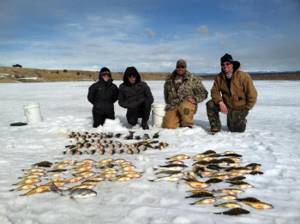
Geography and hydrology
The length of the river is 675 km, its drainage basin area is 24,000 km². The average annual water flow in the lower reaches is about 23 m³/s. Used for irrigation. Flood in March - April (30 days, 86% of the annual flow). Snow food. Freeze up from November to April (in some places it freezes to the bottom), spring ice drift lasts about 7 days. In summer it sometimes dries out. The flow is regulated by numerous dams. It feeds the Saratov irrigation canal.
The sources are on the spurs of the General Syrt, flowing, winding strongly, along a wide valley among the plowed steppe; snow food. It flows into the Volgograd Reservoir below the city of Balakovo.
There are 2 large reservoirs on the river: Sulakskoye (water surface area - 20 km², volume - 0.115 km³) and Pugachevskoye (10 km² and 0.06 km³, respectively). [ source not specified 3044 days
] The route of the Saratov irrigation canal passes through the water area of the Sulak reservoir. [
source not specified 3044 days
] In total, about 800 ponds and reservoirs with a total volume of 0.45 km³ were built in the Bolshoi Irgiz River basin. [
source not specified 3044 days
]
On the river is the city of Pugachev, the villages of Belenka, Tolstovka, Bolshaya Tavolozhka, Staraya Porubezhka, Imeleevka, Klevenka, Kanaevka, Yablonovyi Gai, Gorelyi Gai, Preobrazhenka, Uspenka, Kamenka, Davydovka, Tambovka, Berezovo, Kamenka, Pestravka, Bridges, Dmitrievka, Bolshaya Glushitsa, Samara region, Zavolzhsky village, village. Maloe Perekopnoye village Perekopnaya Luka, p. Sulak, the village of Sukhoi Spur, the village of Beregovoy (Durdom), Krivoluchye-Sura, Bolshoi Kushum, Vetka, Bykov Spur, Kormezhka, Naumovka, Pylkovka, Maly Kushum.
Fishing in Balakovo on Irgiz
The Bolshoi Irgiz is a fairly full-flowing, winding, deep, fish-filled river. Of course, about ten years ago the situation here was more advantageous for fishermen; from known snags, in a few casts it was possible to remove 4-5 kilograms of pike. The subsequent boom in jig fishing did its job. Now “five” pike have become rare, but the standard of 1-1.5 kg is always plenty here. Without straining, you can catch a dozen of them. Fishing in Balakovo on the Irgiz has its own main method - Russian jigging; baits are taken of medium size in bright colors (the water here is always muddy). The weight of the heads is from 20 to 30 grams. The lower reaches of the Greater Irgiz are characterized by constant changes in flow direction. At night, when the hydroelectric station stops operating, the water flow decreases, and the Irgiz actively flows down. The fish is not sleeping at this time; there is a good bite in the morning. When the water rises, the bite becomes average. The worst thing is when the level drops, and then the Irgiz begins to fill up again, then you may not see a bite.
Winter fishing in Balakovo on Irgiz is characterized by the fact that many predators come here for the winter. They climb up the mouth of a school of pike perch and hide in snags in the middle reaches. Fabulous fishing can happen after spring floods on the lower reaches. After the water recedes, entire “fish markets” gather here - sabrefish, perch, pike perch, pike. This time coincides with the lifting of the ban on spinning fishing.
What gear do you use and what kind of fish bite?
It is worth noting that fishing in Balakovo is possible with any gear. If you come to the Volga, then the list of fish here will definitely please you: catfish, carp, bream, pike perch, asp, pike, crucian carp, perch. Local lakes and channels are rich in undergrowth, there are ides, whitefish, and large buffalos. It is worth noting that it is in these places that the famous Volga herring in Russia begins to be caught by the end of summer. Fishing in these places is often combined with outdoor recreation. Every Russian man dreams of sitting on the banks of the Volga, surrounded by flowering meadows and forest oak groves.
Winter fishing on the Volga is no less attractive and interesting. The constant attributes are a drill, a hole in the ice, and a winter fishing rod. Many Muscovites specially go for winter fishing in Balakovo. This is where you can experience all the delights of the winter season.
Fishing on the Volga has many advantages: convenient terrain, recreation centers, a variety of fish species, you can fish with any gear, and you often come across trophy specimens. The main thing you need to have with you: a good mood and a desire to relax. And you will be guaranteed a catch.
Holidays on the Volga
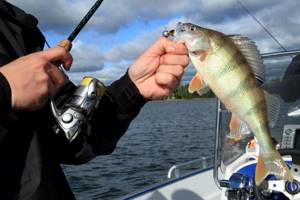
Do you want to relax on the banks of the great Russian river with the whole family? Come to Balakovo, to the health and hospitality yard “Dubrava”. There is something for everyone here. Summer holidays will appeal to both adults and children. Clear water, sandy beaches, silence of the forests - all this creates a fabulous atmosphere. Not only men, but also many women enjoy spending time fishing. It doesn’t matter whether you are an amateur beginner or an experienced fisherman, representatives of the fishing club in Balakovo will create all the conditions for your fishing to be successful. They will select the right place for you, provide you with gear and provide you with a fishing forecast in Balakovo, which will help you figure out where and what is being caught. Not only fishing is available to vacationers in Dubrava. Here you can relax, take wellness treatments (phytosauna, cedar barrel, relaxing massage and others). Romantic couples often come here who want to escape from the bustle of the city and just be together in silence, away from everyday worries.
Fishing on Kalinich
In April, fishing opens on Kalinikha (Balakovo). Here you have the opportunity not only to go fishing, but also to spend time with friends or the whole family. You can use the services of the base, which is called “Fishing on Kalinikha”. There is an excellent opportunity to gather in large groups and even hold special events. The bite forecast in 100% of cases promises a catch at any time of the day, if not one, then another breed of fish. Trophy specimens can be grass carp, dace, bream, chub, and bersh. The most common specimen here is carp. There are even competitions organized to catch it, which bring together fishermen not only from the Saratov region, but also from neighboring regions.
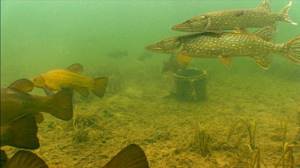
Saratov HPP
It is in Balakovo that the Saratov hydroelectric power station is located. Almost two hundred kilometers from Saratov itself. The hydroelectric dam divides the Volga into reservoirs - Volgogradskoye and Saratovskoye. By the way, it’s six hundred kilometers from here to Volgograd. Visitors often get confused about the names. There is a legend why the hydroelectric power station was named Saratov. During the division of industrial facilities in the 50s, one of the party leaders said that Balakovo has its own nuclear power plant, even if then at least the hydroelectric power station bears the name of the regional center, like Saratov does not lag behind the growth of industrial production, so they began to call it Saratov .
Features of fishing in Balakovo
Paid fishing in Balakovo has not yet become widespread. In most cases, you can still enjoy a free holiday. Many lakes and streams in this area provide this opportunity. Above we described the reservoirs where you can come to fish. What is special about fishing in these particular places? The depth here can vary from one to ten meters or more. The population level is different everywhere. More than seventy species of underwater live, including crucian carp and sturgeon. Each species has its own habits and tricks. For fishing to be successful, you need to find the right approach. Why do some people claim that there is no bite? This does not mean that there are no fish in the reservoir. You just need to know a number of factors that are very significant when making a fishing forecast. All of them must be taken into account in strict sequence:
- Object of fishing.
- Season.
- Times of Day.
- Atmosphere pressure.
- Bottom relief.
- Water temperature.
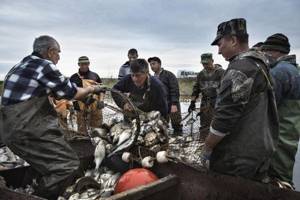
Dam on the Irgiz River
The dam has the following latitude coordinates – 51°51′48.12″ and longitude – 48°17′30.76″. It was built to supply the Saratov Canal. After the rains and at the beginning of summer, the water there is dirty and cloudy, but the rest of the time it is mirror clear. During hot weather, people in this area escape the heat. In winter there is practically no one, so people come here to enjoy nature and the beautiful view. You can get to these places in 2 ways. For example, enter from the highway, turning towards the Maloperekopnoye area. Or move from Sulak. Dirt roads lead to the dam, along which absolutely any passenger car can pass.
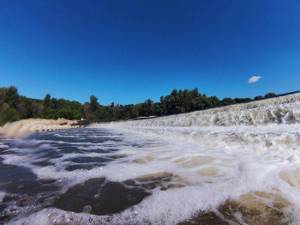
Object of fishing. Season
If you are going fishing in Balakovo, your fishing must be predicted. One of the forecast criteria is the fishing object. The habits of each type of fish have their own distinctive characteristics and are determined by external factors. For example, carp changes its diet depending on the season; this is important to take into account when preparing bait and bait. Catfish are completely inactive in winter; you should not expect them at this time of year. Pike and perch can be caught even from under the ice; you can go for them with a winter fishing rod (with a jig, a spinner). The peculiarities of fishing according to the season make the fisherman think about what tackle, bait and groundbait to choose. Even in the most favorable season, an incorrectly selected bait (for example, for perch) can lead to zero results. When aiming for a specific result, predict the bite correctly.
Times of Day
Different species of fish live in Balakovo reservoirs, and the activity of each depends on the time of day. Don't expect to catch a catfish on a hot summer day. This predator is well hidden in some deep hole or under a snag, and it is unlikely to be lured out during the day. Catfish are nocturnal predators. Non-predatory representatives, which feed mainly on plankton and also mollusks, are mostly active in broad daylight. The peak of the bite is observed at dawn or at sunset.
general information
In the Saratov region, the Irgiz River originates at the branch of the General Syrt. The source coordinates are 52°12'34" N. latitude, 51°18'55" e. d., mouth coordinates – 52°0'49" s. latitude, 47°23'7″ e. d. The river flows into the Volga and belongs to the Lower Volga basin. Irgiz has a large drainage basin area - 24 thousand km, and the length of the river is 675 km. The current is slow, like most large and developed water streams. In summer, the Bolshoi Irgiz dries up, and from November to March there is ice drift on the river. In some places the Irgiz River freezes completely. And many dams have been built throughout the drainage.
The Sulak and Pugachev reservoirs are two water areas located on the river. About 800 artificial reservoirs and ponds have been created, with a total volume of about 0.45 km³.
Atmosphere pressure
Some species of fish react very sensitively to changes in atmospheric pressure. It is impossible to predict a successful bite if the pressure is unstable. When you are going to go to a pond, be sure to take this parameter into account. Experienced fishermen have special barometers and record changes in atmospheric pressure. The graph allows you to make a correct forecast of the stability of this indicator in the near future.
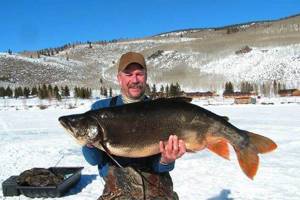
Bottom relief
So, you have arrived in Balakovo. Fishing in which the bite forecast does not take into account the correct choice of terrain may not bring the expected results. The bottom topography plays a direct role in the bite. Keep in mind that large fish rarely appear in shallow water, and in deep water you will not be able to catch anything with a float; serious tackle is needed here. However, in shallow water you can get a good catch, given the places where the water quickly warms up, is enriched with oxygen, and crucian carp will bite well here.
Water temperature
Each type of fish feeds in a specific temperature range. In salmon, for example, it is much lower than in carp. If you make a forecast in advance and know what the water temperature is in the reservoir where you are going, you will be able to determine which type of fish will bite best during your fishing trip.
So, when drawing up a fishing forecast in Balakovo, it is worth taking into account all of the above parameters: season, pressure, time of day, water temperature. The rest will depend on the skill of the fisherman himself. To make fishing forecasts, many often resort to the media and the Internet. Experienced fishermen, based on their experience, make their own, more reliable forecasts.
Sources:
https://mesto-kleva.ru/map/746.html https://fb.ru/article/260198/irgiz—reka-v-samarskoy-i-saratovskoy-oblastyah-opisanie-otdyih-i-ryibalka https: //www.syl.ru/article/287036/new_ryibalka-v-balakovo-prognoz-kleva-i-osobennosti-ryibalki
